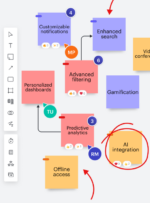
There are a few definitions of “value stream management” floating around out there. Most seem pretty good, but they are necessarily very broad and maybe vague. That’s because value stream management is a very broad concept. Given the hype around these 3 words, and how it’s often shortened to 2 words, there is a lot of confusion. Maybe it will help if we discuss what value stream management isn’t.
So, let’s first look at the way Chris Condo of Forrester described it at the virtual VSM DevCon that took place in July:
“A combination of people, process, and technology that maps, optimizes, visualizes, measures, and governs business value flow (including epics, stories, and work items) through heterogeneous enterprise software delivery pipelines. VSM tools are the technology enabling the practices of VSM.”
Now for what it isn’t:
Value stream management isn’t the same as value stream. “Value stream management” is a clumsy phrase. I see many people shorten it to just value stream. We shouldn’t do that. Some people do it out of ignorance; they really aren’t sure what all this value stream stuff is about and they don’t understand the difference. That’s okay and understandable. Others do it out of laziness, and that creates confusion. Because people who should know better aren’t diligent and precise, learners are more likely to use the wrong term when asking questions, and then not get the right answers to their questions.
RELATED CONTENT: Value stream is not as easy as it seems
Value stream management isn’t a defined process. Note that I never capitalize those words: value stream management. Capitalizing it makes people think it’s something they can go buy or learn or license. Sure, you can learn how to identify, discuss, improve, and manage your value streams better, but there is no specific “Value Stream Management ® ™ ©” process or program to follow as there is with Scrum or the Kanban Method or DSDM or SAFe or Six-Sigma or TQM or TDD, and the like. It’s similar to how you should use lower case k when discussing your Kanban, but initial caps when writing about the Kanban Method.
Thankfully, at least some others seem to agree. On Forrester’s website I see it in lower case: “Practicing value stream management (VSM) allows companies to turn their Agile-plus-DevOps environments into real digital business drivers.” Likewise, here’s a quote from digital.ai’s website: “infrastructure and operations leaders are increasingly revisiting their toolchain strategies to implement DevOps value stream management platforms (VSMPs).” There’s an article in Forbes that also gets it right. Some others don’t seem to follow this convention, creating confusion. In fact, one of my competitors is a big offender.
Value steam management isn’t a tool or a platform. To manage a value stream is a human endeavor. Tools can help provide visibility into the status of the items moving through your value stream. They can help you see how much WIP you have, and maybe help the humans limit that WIP. Tools can give you info on lead time and its trend (improving or worsening). Tools can help enforce governance. Tools can automate and orchestrate. And tools can help collaborate. But don’t think your job is done after buying something that calls itself a value stream management platform.
Value stream management isn’t the same as value stream mapping. Value stream mapping is a useful technique. Mapping can help everyone get on the same page about their value streams, processes, and bottlenecks. Mapping can help everyone get on the same page with regard to a desired future state. Value stream mapping gets stressed well enough — that’s the visualization in Forrester’s definition. But you can manage your value stream without a value stream map.
Value stream management isn’t the same thing as DevOps, or Agile, or Scrum, or lean, or kanban. All of those things are useful. All of them can help you manage your value stream. But they aren’t synonymous. You can manage your value stream without any of those. You can use Waterfall with your value stream. You can have and manage value streams without any DevOps.
Value stream management isn’t a person, though you might have many people managing a value stream. You might even have a person with the title or role or responsibilities of value stream manager.
Value stream management isn’t just project management, but project management activities and approaches are an important part of managing a value stream. This includes the “governance” part of Forrester’s definition.
Many of the value stream manager job descriptions that I’ve seen look just like every project manager job description I’ve ever seen. Plutora has one on their blog that is a good example of what I mean. It’s not a bad job description, except that it is too much about managing the flow (like an expeditor and project manager — working IN the value stream) and not enough emphasis on working ON the value stream, about improvement.
Building on that, value stream management is a bit of a misnomer. In other places I have said that we need to move beyond value stream management and move on to value stream leadership. A lot has been written on the difference between management and leadership. Such a distinction isn’t quite the same thing working IN the value stream vs. working ON the value stream, but it’s catchy enough to make the point that there is something more to think about than managing. Because of the management vs leadership dichotomy, “managing” a value stream picks up the same kind of connotation. Therefore, value stream improvement is woefully underemphasized.
DevOps Engineer Chris Trotter put this very well: “The ideas around improving process are also (as a pattern I’ve observed) almost always constrained to the immediate context. The concept of mapping across the holistic (systems) context is generally met with ‘I don’t see the value in that’.”
Misuse of this phrase and sloppy language leads to phrases like:
- “…users of value stream management.” Value stream management isn’t something you can “use”.
- “I want to introduce the value prop of value streams” and “How can I highlight the benefits of value streams?” Value streams just are. They exist. You can introduce the value of thinking about your value streams, about mapping them and improving them. But “value prop of value streams” is like saying you can switch to using value streams where you used to not have a value stream at all. Your value stream might not be understood, but it already exists just the same.
- “How can we experiment with value stream and validate that it’s a useful thing to do?” Remember, value stream management isn’t some new thing, though thinking about it may be new to some organizations. Value stream management isn’t a thing that you can decide to do or not do. Your organization is doing it whether they realize it or not; whether effectively or not. Well, maybe that’s not true. I suppose an organization could possibly have an unmanaged value stream. But that would be akin to having an unmanaged organization. The value stream still exists.
- “What is the value prop of value stream management?” Asking what is the value one gets out of managing a value stream seems like a strange question to me, akin to asking what’s the value out of managing my finances. Or akin to asking what’s the value out of managing my business. I’m not criticizing people who are asking questions, trying to understand what all of this is about. I’m asking those of us writing and speaking about this topic to use a little more precision.
There are many definitions of value stream management out there. I think that’s fine. I don’t think we need a single “official” definition. But by defining what it isn’t, I hope that I’ve been able to clear up at least some of the confusion. And perhaps, with time and more precise language, we will collectively come to a better understanding of what value stream management really is.






